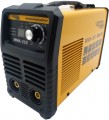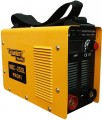Minimum input voltage
The minimum actual input voltage at which the welding machine remains operational.
Such information is useful primarily for working in unstable networks, where the voltage tends to “sag” a lot, as well as from autonomous power sources (for example, generators), which can also produce voltage below the nominal one.
Power consumption
Power consumption of the welding machine, expressed in kilovolt-amperes.
kVA is a unit of power used in welding machines along with the more traditional kilowatts. The physical meaning of both units is the same — current multiplied by voltage; however, they denote different parameters. So, in kilowatts, only a part of the total power consumption is recorded — active power (goes to do work and to losses due to heating of individual parts); according to this indicator it is convenient to calculate the practical capabilities of the device. And kilovolt-amperes denote the total energy consumption — it also takes into account reactive power (it goes to losses in coils and capacitors during the operation of alternating current circuits). This data is useful for calculating the total load on the network or other power source.
The apparent power input in kVA will always be greater than the power in kW. However, some manufacturers go to the trick and indicate full power not at full, but at partial (for example, half) load. This gives the impression of efficiency, but is incorrect from a technical point of view. As for the ratio of energy consumption, the active power in kW is often 20-30% lower than the apparent power in kVA. So, in terms of kilovolt-amperes, it is quite possible to evaluate the performance of the unit.
As for specific values, in the most modest models they
do not exceed 3 kVA. An indicator
up to 5 kVA is considered low,
up to 7 kVA — average, and in the most powerful units, the power consumption can reach
10 kVA or even
more.
Electrode holder cable
The length of the electrode holder cable supplied with the device.
As the name implies, this cable is used to connect the clamp for the welding electrode to the machine. The longer such a wire is, the more freedom the welder has in moving, the farther he can go without moving the machine itself. On the other hand, excessively long cables create problems in storage and transportation, and often during operation (you need to look for a place where to place the excess wire). Therefore, when choosing, you should proceed from what is more important for you: the ability to move away from the device or the overall compactness. As for specific numbers, most often the length of this wire varies from 2 to 3 m, but in some models it can reach 5 m.
Mass cable
The length of the ground cable supplied with the machine.
The mass cable is a wire that is connected to the workpiece with a clamp. In other words, this is the second contact required to close the circuit during electric welding; connecting such a wire actually turns the workpiece into one solid fixed electrode (paired with a movable welding electrode). As for the length of such a wire, the longer it is, the farther from the connection point you can place the machine and the more freedom of movement the welder gets. On the other hand, excessively long wires create problems in storage and transportation, and often during work (you need to look for a place where to place the excess cable). In addition, freedom of movement can be ensured by increasing the length of the second wire — for the electrode holder or burner. Thus, the mass cable in modern welding machines usually has a length of 1.2 to 3 m (with some exceptions — both smaller and larger). This length allows you to comfortably place the device and at the same time does not create problems.
Case (bag) included
The presence of a
case or bag for storage and transportation in the scope of delivery of the welding machine.
Cases are characteristic hard containers in the form of a suitcase; such containers provide excellent protection against moisture and dirt, as well as against impacts. Bags, in turn, are made soft; they are inferior to cases in terms of the quality of protection, but they are less bulky and can be folded quite compactly when not needed. Well, anyway, complete packaging usually turns out to be more convenient and practical than impromptu.

